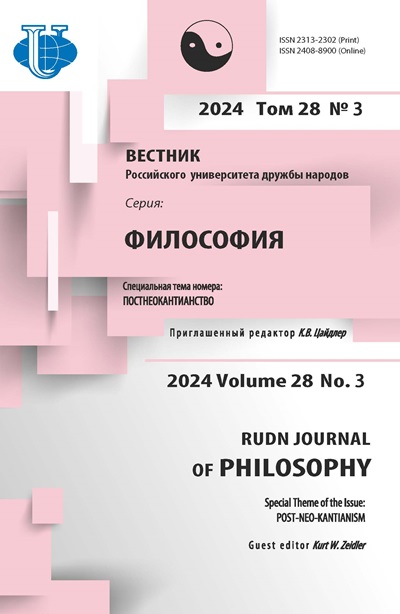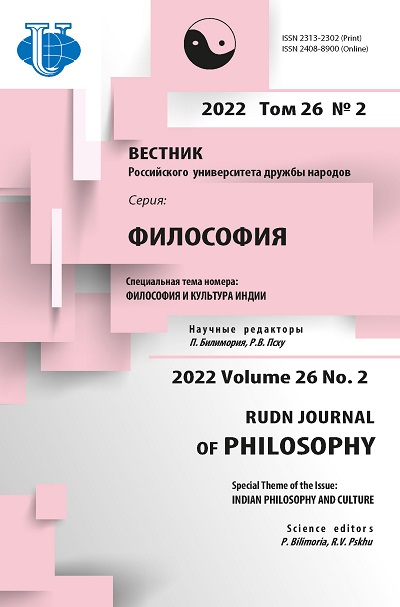Джайнская этика и медитация: процесс самоочищения через кармический круг
- Авторы: Мукхерджи А.1
-
Учреждения:
- Университет Висва-Бхарати
- Выпуск: Том 26, № 2 (2022): ФИЛОСОФИЯ И КУЛЬТУРА ИНДИИ
- Страницы: 305-324
- Раздел: ФИЛОСОФИЯ И КУЛЬТУРА ИНДИИ
- URL: https://journals.rudn.ru/philosophy/article/view/31366
- DOI: https://doi.org/10.22363/2313-2302-2022-26-2-305-324
Цитировать
Полный текст
Аннотация
Основной задачей этой статьи является - изучение взаимосвязи между джайнской этикой и техниками медитации, предлагаемыми в джайнских священных текстах и основах учения джайнизма. Медитативные практики использовались в джайнской традиции на протяжении веков. При этом мы обнаруживаем весьма разные интерпретации медитации в священных текстах (особенно если сравнивать трактовки дигамбаров и шветамбаров), что также отражается и в самой практике медитации. В случае джайнской традиции сложно отделить этику от духовного пути освобождения и медитации как практики. В рамках данного исследования на основе Таттвартха-сутры, Уттарадхьяяны и Ачаранга-сутры предпринята попытка показать, что этика (в узком смысле) может пониматься как всего лишь один из аспектов медитации, если понимать под медитацией весь духовный путь, описанных в учениях джайнизма. Описанные в джайнских сутрах четырнадцать стадий можно считать стадиями этического пути, или медитации. В наше время приобретает популярность прекша-дхьяна - обновленная форма медитации, которая переводит эти стадии в более мирские практики, предлагая более доступную и простую форму духовного пути. Однако предельная, конечная цель остается неизменной - достижение самоочищения через кармический круг.
Ключевые слова
Об авторах
Аша Мукхерджи
Университет Висва-Бхарати
Автор, ответственный за переписку.
Email: ashamukh@gmail.com
ORCID iD: 0000-0002-6126-9252
PhD, профессор кафедры философии и религии, руководитель центра Women Studies
Индия, 731235, Западная Бенгалия, ШантиникетанСписок литературы
- Jaini Padmanabh S. Gender and Salvation: Jaina Debates on the Spiritual Liberation of Women. Berkeley: University of California Press; 1991.
- Bhagava Dayananda. Jaina Ethics. Delhi: Motilal Banarasidass; 1968.
- Uttaradhyayana and Sutrakrtanga. Jacobi H, translator. In: Sacred Books of the East. Vol. 45 [Reprinted]. Delhi: Motilal Banarsidass; 1964.
- Umasvati/Umaswami. Tattvartha Sutra. Tatia Nathmal, translator. Delhi: Motilal Banarsidass; 2007.
- Kundakunda. Samayasara. Jaini JL, translator. Lucknow: Central Jain Publishing House; 1931.
- Dharmachandvijay J. Sutrakrtanga Sutra. Mahavir Jain Vidyalay; 1978.
- Jaini Padmanabh S. The Jaina Path of Purification. Delhi: Motilal Banarsidass; 1981.
- Williams R. The Jaina Yoga: A Survey of the Mediaeval Sravakacaras. Oxford: Oxford University Press; 1962.
- Chanchreek KL, Mahesh Kumar Jain, editors. Encyclopaedia of Jain Religion. Vol. II. New Delhi: Sree Publishers; 2005.
- Vishrut Vibha. An Introduction to Preksha Meditation. Rajasthan, Ladnun: Jain Visva-Bharati; 2009.
- Yuvacharya Mahaprajna. Preksha Dhyana. Kumar MM, Zaveri JS, translators. Rajasthan, Ladnun: Jain Visva-Bharati; 2007.
- Acaranga Sutra. Jacobi H, translator. In: Sacred Books of the East. Vol. 22 [Reprinted]. Delhi: Motilal Banarsidass; 1964.
















